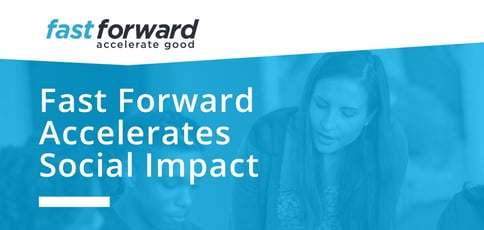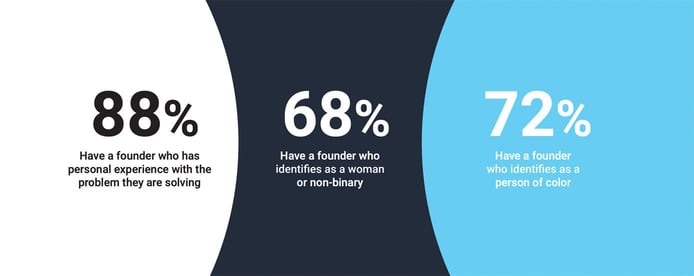
TL; DR: Fast Forward is not your average tech accelerator. The San Francisco-based organization is focused on helping entrepreneurs use innovation to fight social injustice — not hit the Fortune 500. Whether investing in its portfolio of tech nonprofits, raising philanthropic capital, or organizing an extensive directory of nonprofit tech groups, Fast Forward’s goal is to invest in the future of humankind.
It’s easy to become disillusioned with the tech industry, where achievements are primarily measured in dollars earned. With almost mechanical regularity, we’re seeing entrepreneurs take their startups to the next level by leveraging the rich landscape of venture capitalists, angel investors, and accelerators set out before them.
For tech nonprofits — the ones looking to use innovation to spur social change — the experience is not always as fruitful. That’s why, since 2014, Fast Forward has been investing in projects and programs designed to bridge the gap between the tech and nonprofit sectors.

Shannon Farley, Co-Founder and Executive Director, described how Fast Forward is making way for social good.
“There are ample funding opportunities in the startup world — you can almost map out your startup journey just by Googling how to do so,” said Shannon Farley, Co-Founder and Executive Director at Fast Forward. “Our goal is to create an ecosystem of support for founders who started a nonprofit because they saw customers that weren’t being served by for-profit software.”
To date, 50 groups have participated in the Fast Forward accelerator. Last year alone, they served more than 63 million people and raised $157 million in follow-on funding to solve some of the world’s most pressing social issues in healthcare, education, human rights, and beyond.
Ultimately, through the accelerator, as well as philanthropic capital, a Tech Nonprofit Playbook, and a vast nonprofit community, Fast Forward is investing in social impact across the globe.
Bridging the Gap Between Social Services and Tech
Shannon and Co-Founder Kevin Barenblat leveraged a combination of their professional backgrounds when launching Fast Forward in 2014.
“Kevin had been steeped in the tech startup environment after launching and selling a previous tech company,” she said. “He was interested in why there weren’t more tech nonprofits, such as Khan Academy, that have software at the core of their impact model.”

Fast Forward serves a diverse set of entrepreneurs working to grow tech nonprofits.
Prior to Fast Forward, Shannon concentrated on philanthropy, juvenile justice reform, and gender equality. She served as founding Executive Director of Spark, the world’s largest network of millennial philanthropists, and co-founded The W. Haywood Burns Institute, a juvenile justice reform organization.
“I ran a women’s foundation for many years that was essentially an early tech nonprofit,” Shannon said. “We operated with a wiki and a PayPal account, and that’s how we distributed all of our funds. So when Kevin and I got together as co-founders, we wanted to bridge our two worlds.”
With the belief that the most cutting-edge technology should be applied to the world’s biggest social problems, Fast Forward set out to offer community, funding, and guidance to tech nonprofits. It’s a good thing they did: Today, amid a global pandemic and economic meltdown, online social services are more important than ever.
“Our groups are working to address the crisis points — distance learning, access to telemedicine, access to legal aid when courts are closed, support for mental health services,” Shannon said. “For nearly anything you could imagine that people need at this moment, there is a tech nonprofit serving that need.”
The Goal: To Unite the Tech Nonprofit Community
Shannon said many tech professionals, including engineers, get into the field because they love solving difficult problems. But somewhere along the way, they lose a connection to the issues that matter.
“If you didn’t grow up in a community in which these issues are ever-present, you may not have exposure to the nonprofits that can take advantage of your valuable skills,” she said. “Our goal is to help skilled professionals find meaningful ways to engage with tech nonprofits — whether it be through full-time roles or pro-bono volunteering.”
By bridging this gap, Fast Forward aims to help connect a community of people interested in advancing social impact via technology.
One way the nonprofit achieves this is through its Tech Nonprofit Directory, a free, comprehensive database of innovative nonprofit tech companies and entrepreneurs. Users can search the directory using a range of categories, including program area, geography, and budget, to connect with nonprofit organizations and communities.
Fast Forward also created an open repository of pro bono needs that can help those affected by COVID-19. Often, these are tasks that could make a big impact — such as code reviews in GitHub — that a software engineer sitting at home with a half an hour could do. Rather than turning to soup kitchens, which have attracted droves of volunteers lately, those who possess the required skills might consider helping a tech nonprofit in a food-related area.
“If there isn’t a need for volunteers in a soup kitchen, you could instead work for a food discovery platform that’s connecting people to free meals,” she said. “They need SEO support, backend database management support — all of the things any tech company would. There’s a real opportunity for people in the tech sector who have traditionally been shut out of pro bono volunteer opportunities to dive in quickly.”
Investing in the Future of Education, Healthcare, and Human Rights
Fast Forward approaches its mission through the lens of social justice, working to solve some of the world’s biggest challenges.
“In cities, particularly, but also throughout the country, it feels like the work that the tech and nonprofit sectors do is divorced from one another, but the truth is, it’s all connected,” Shannon said. “We’re feeling that in a meaningful way as all of the different crises we’re facing expose holes in our social safety net. The divide between sort of tech business and every other kind of business is glaring.”
And while those in education, healthcare, and human rights deserve the best possible technology to address the problems facing our society, they’ve historically been shut off from it financially. Fortunately, Shannon said, cloud technology is forcing the costs of computing downward, presenting new opportunities.
“If you launched a tech startup 10 years ago, you’d need millions of dollars,” she said. “You’d need to set up a server closet, and it probably wouldn’t be where you work. You’d have to rent a truck to haul everything around, and hire an expert to set it up,” she said. “Now, there is an entire universe of products that help people start tech nonprofits — we’ve had teams do it for approximately $5,000.”
TalkingPoints, a nonprofit launched in 2015 by Fast Forward alumni Heejae Lim, is one example of this. Studies have shown that the most significant indicator of high-school graduation rates is not zip code but parental involvement. To increase engagement between teachers and multilingual families, the organization created a website that combines Twilio’s cloud communications platform with Google Translate.
“They paid a few thousand dollars for a rudimentary website to get started,” Shannon said. “Now, TalkingPoints is helping tens of thousands of parents communicate with teachers in many different languages, especially the long tail languages that are not served by for-profit products in the market. Suddenly, parents can communicate with their children’s teachers; it’s something that wouldn’t have been possible with the technology we had 10 years ago.”
The Tech Nonprofit Playbook: Packed with Best Practices
Fast Forward recently released the Tech Nonprofit Playbook, a free guide to launching and growing a tech nonprofit. The online resource provides incredibly comprehensive yet approachable advice from the leaders whose work has transformed the social impact space.
“It’s been a dream of ours since the beginning to open-source everything we’ve learned in the last six years, including how our founders have used their nonprofit status to scale up quickly to serve people who otherwise weren’t being served,” Shannon said.
The idea is to open up access to opportunity in an unprecedented way beyond San Francisco’s borders.
“There are great ideas everywhere — not everyone happens to live in a seven-mile radius where suddenly you could have access to lots of different startup support,” Shannon said. “Often, these ideas have been burrowing in their mind for a long time. We hope this tool will help them bring new products into the world — because people need help now more than ever.”
HostingAdvice.com is a free online resource that offers valuable content and comparison services to users. To keep this resource 100% free, we receive compensation from many of the offers listed on the site. Along with key review factors, this compensation may impact how and where products appear across the site (including, for example, the order in which they appear). HostingAdvice.com does not include the entire universe of available offers. Editorial opinions expressed on the site are strictly our own and are not provided, endorsed, or approved by advertisers.
Our site is committed to publishing independent, accurate content guided by strict editorial guidelines. Before articles and reviews are published on our site, they undergo a thorough review process performed by a team of independent editors and subject-matter experts to ensure the content’s accuracy, timeliness, and impartiality. Our editorial team is separate and independent of our site’s advertisers, and the opinions they express on our site are their own. To read more about our team members and their editorial backgrounds, please visit our site’s About page.

